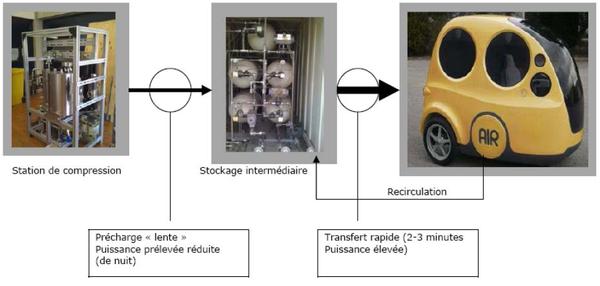Faster fill-ups for compressed air cars

© 2011 EPFL
As part of a partnership with a French company that develops compressed air vehicles, EPFL scientists have solved the main drawback of this technology: vehicle recharge time. They have developed a prototype for a quick-stop recharge station that can fill up a tank in less than three minutes.
Already in use in some airports, compressed air vehicles developed by the French company Motor Development International (MDI) could soon charge their tanks in less than three minutes, instead of the several hours that have been needed up to now. In the context of a partnership with the company, researchers from Professor Alfred Rufer’s Industrial Electronics Laboratory (LEI) at EPFL have developed a prototype for a quick-stop recharge station that can fill up a tank of compressed air the same amount of time it takes to fill up a regular gas tank, for an autonomy of about 70 km.
Transferring air in stages
The new recharge process is done in two stages (see schematic below): first the air is compressed in a high-performance compression station and transferred to an intermediate storage station. Because it’s continually being refilled from the compression station, the intermediate storage station is able to maintain quasi-constant pressure conditions.

In the second stage, the compressed air is transferred from the intermediate storage station to the car’s tank, this time very rapidly, using a flow-limiting process in which very little energy is dissipated. The only problem is that during this accelerated compression, the air heats up in the vehicle’s tank. When it cools down, it contracts, reducing the pressure in the reservoir and, consequently, decreasing the vehicle’s autonomy.
The solution: recirculating the air
In order to fill the tank in an optimal manner, Rufer’s team designed a system that recirculates the air during fill-up, which instantly cools the reservoir. The air that’s warmed up by pressurization is sent back to the storage station, then replaced by cooler air, all under constant pressure conditions. The fill-up is thus done in two stages, allowing the density of the air in the tank to be increased and the temperature to be stabilized. “Using this method, the yield from the transfer is theoretically close to 95%,” notes Rufer.
Longer version of the article: STI homepage
"Car of the Future", from Ideaslab, the World Economic Forum at Davos
Plus d'informations: Driving and Filling Personal Vehicles – The Questions of Energy - and Power - Density
( A Fast Filling Station for the Compressed Air Car )